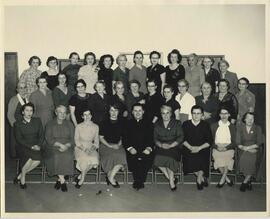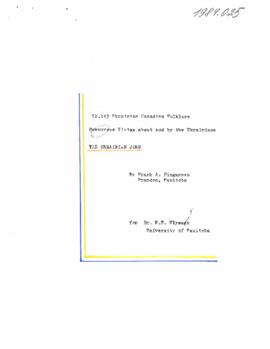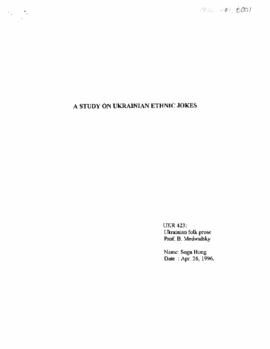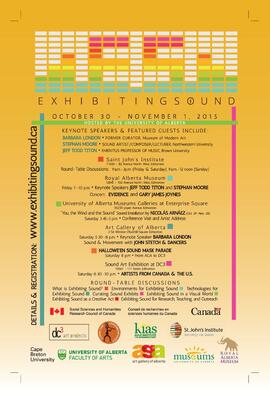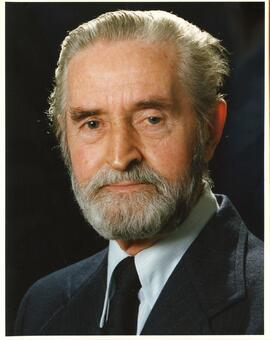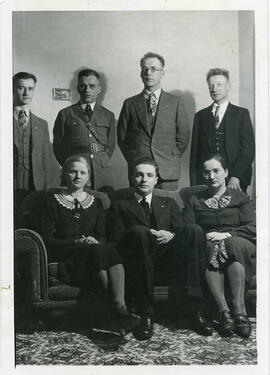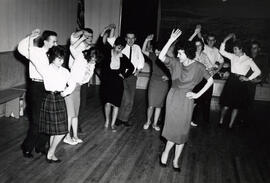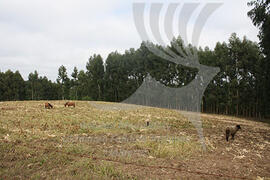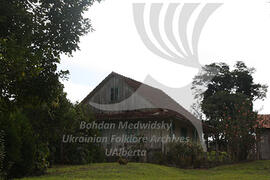Inscription on back:
"Oct. 30, 1993
Chateau Louis
Julian Koziak
Sasha Brice
Wedding St. Basils
Reception- Masquerade Ball
Taken by Dr. V. Bayrock"
Front Row: Peter Savaryn, Orest Zarsky, Harry Bratkiw, Joseph Stepa, Walter Janis, John Gulayets
Second Row: Jerry Kitt, Victor Bayrock, Dan Kobasiuk, Mike Magus, Nick Ochotta, Orest Mulka, Fred Sharun
Third Row: Peter Dackiw, Michael Chomiak, Harry Yakymechko, Teodor Wojtiw
A photograph of the 50th wedding anniversary of Orest and Emilia Zarsky. Note their wedding picture at the background.
This item contains recordings from the Second Banff Conference on Central and East European Studies.
Presentation by Mr. Petr Czarnowsky: Eastern Europeans, despite their proportion of the population, came to form a large number, often over 50% of ethnic associations in Alberta. This includes ethnic organizations, arts organizations, and linguistic schools. Policies of multiculturalism have helped to form these figures, but have had the unforeseen consequence of adding to confusion about Eastern European ethnic groups on the part of students and teachers alike.
Presentation by Mr. Joanna Mateko on the problems already being faced in the study of Poles. She came from Poland associated with the Polish Academy of Sciences in Warsaw for 15 years. She did work in the field of Polish history, having published numerous articles and co-author of bibliographies that were compiled by the Polish academy of sciences. She does her research on the Poles in Alberta. A problem that exists in the study of Poles is the inaccuracy of academic and official documents pertaining to Polish settlement in Canada, and the difficulty in unearthing accurate depictions and statistics of Polish settlers, and Slavic settlers more generally. This can be derived from a lack of knowledge from Canadian officials, and a lack of consciousness amongst many Slavic groups, particularly the Poles and Ukrainians.
Presentation by Mr. John Sokolowski, a graduate student in the department of Slavic Languages, his first graduate program was as a Classicist. He does work on the Russians and Belarussians. He started his work on the East Slavs, the Russians, Belarussians, and Ukrainians in Alberta. They no longer work on the Ukrainians as so much work has been published. They started their study with the Russians and Belarussians, they hope to determine an accurate number of people of Russian and Belarussian origin in Alberta. Contention on the accurate number of Russians and Belarussians in Canada, as the definition of Russian has changed over time, with many early documents associating many non-Russian ethnic groups as Russian. Dynamics have changed with census records over the years, which still continue to be unreliable. There is thought to be far more Belarussians in Canada than official census documents would suggest.
Presentation by Mrs. Dr. Yermilla Horna University of Calgary Department of Sociology. Dr. Horna was educated in Prague and Bratislava came to Canada in ’58, taking part in the project doing the history of the Czechs and the Slovaks. She got a grant for the study of patterns of adjustment of Czechoslovaks, the so called refugees of 1968-1969. The study focused on pre-1968 settlement of Czechoslovaks in Canada to figure out if incoming refugees had a previous basis to go off of, or had to ‘start from scratch’. Research found majority of Czechoslovaks came to Alberta as miners, farmers, or other labourers, mostly from Slovakia. Greatest wave of Czechoslovak migration prior to 1968 came in 1885.
Presentation by Mr. Kostash: Talks about the function of universities. Talks about how East European and Soviet Studies at the university follows the same functions. Mentions that one who takes particular focus on the East European courses offered by the University can find themselves being skilled and knowledgeable scholars. Initiatives by professors at the university to make sure students in the field go out to the ethnic communities to get a feel for how they are. Talks about the importance of community approval and funding for new programs. Stresses transparency of activities in programs as it relates to the community.
Presentation by Mr. Duruviches, a member of the Lithuanian community, and President of the Baltic Society: Discusses the contention with the label ‘Soviet’, coming from Lithuania, and the history Lithuania has with the Soviet Union. The importance of having a place such as a University to study one’s heritage. Expects from the University that it is kept in mind that although their issues are similar at the moment, that Baltic peoples are not Slavic peoples.
Presentation by Dr. Bergin from the Faculty of Education: has a strong interest in Mennonite culture. Difficulties because of mixed loyalties on representing different groups; particularly the Mennonites, who aren’t easily identified by typical visages.
Presentation by Dr. Sukoversky: the definition of a collection, and that professors start collections. Students can start collections too. Ethnic groups can start collections.
Presentation by the Chairman of Edmonton Historical Board
Presentation by Mr. Kistner: Wasn’t prepared to present but is talking from the perspective of a foot soldier. He is Baltic German born in Tallinn Estonia. Talks about how maps often forget about the islands of Estonia. Baltic Germans is a very small group. It’s worthwhile for even very small groups to write their history and preserve their heritage. In doing work there’s lots of assistance needed, time, and footwork. Being a small group has its advantages, no need for sampling.
The book was prepared by Ellery Duncan for her history class at the University of Victoria.
Untitled"The Ukrainian Joke" includes a recollection of Ukrainian Jokes as told by Ukrainian immigrants in Canada.
Untitled"Study on Ukrainian Ethnic Jokes" describes jokes collected in Edmonton that encompass perceived behavior, customs, personality, or other traits of Ukrainians. Includes questionnaire and recorded interviews.
In the fall of 2015, the Canadian Centre for Ethnomusicology at the University of Alberta, with primary funding from SSHRC and additional support from KIAS, Faculty of Arts, Department of Music, Museums and Collections Services, Art Gallery of Alberta, dc3 Art Projects, Royal Alberta Museum, St. John’s Institute, and Cape Breton University, organized a symposium "Exhibiting Sound." The symposium took place at different venues in Edmonton on October 30 - November 1. "The symposium intended to advance creative, collective, blue-sky thinking about exhibiting sound: its natures, purposes, environments, and technologies; the processes of its curation; its relation to visual culture; and its role as creative, pedagogical, and scholarly output, across all the academic fields: arts, humanities, social science, science, and applied science." (http://www.exhibitingsound.ca)
Larisa Sembaliuk Cheladyn collaborated with the musician John Stech (Stechishin) and dancers Anastasia Maywood and Tatiana Cheladyn to explore and interpret three folksongs from the "Kymasz files". The performance took place on Saturday, Oct. 31 at the Art Gallery of Alberta as part of the symposium. The performance was followed by the Q&A and the four creators' reflections on the creation process.
Maryna Chernyavska, the archivist at the Kule Folklore Centre, filmed the performance.
The collection consists of the video recording of the performance and the Q&A and the symposium poster.
UntitledThe collection consists of materials assembled by the creator when he served as secretary for the Ukrainian Catholic Council, the Ukrainian Catholic Brotherhood, and the Honorary Committee of a banquet in honor of Cardinal Slipyi. The collection includes correspondence, minutes, and financial reports. It also contains discrete materials of other organizations where the creator was a member, newspaper clippings, bulletins, photographs, and honorary charters.
UntitledOne photograph featuring a group of people and the following note "First row - left to right: Nelli Bayduza, Danylo Скоропадський, [?] Bayduza; second row: left to right, P. Romaniuk ?, (?), Roman Bayduza, Ladyk (Vladimir) Bayduza. Derwent, Alberta (1936-1937)?"
The series comprises materials related to Parasia Iwanec exhibitions. These are photographs taken at the expositions in the National Hall of Edmonton (1971), the St. Basil's Cultural Centre in Edmonton (1973), the Medical Women's Club (1974), the Stony Plain Multi-Cultural Centre in Alberta (1976), Ottawa Public Archives Museum (1978), the Ukrainian Free University in Munich, Germany (1985), the St Catharines Ukrainian Black Sea Hall (1979, 1985), the Niagara Falls Art gallery (1987), the Brock University in St. Catharines (1988), Parliament Building in Ottawa (1988) and others. The photographs show Iwanec paintings on display, as well as audience and receptions. The series also includes materials of other exhibitions such as invitations, programs, announcements, lists of the canvas offered for different exhibitions, prices of artworks on sale, speeches at openings, certificates of honor, biographical information and lists of exhibitions.
UntitledThe collection is comprised of Rusalka Dance Ensemble archives, Nadia’s original choreography created for Rusalka, as well as related notes, correspondence, and reference materials for her creations.
UntitledAn example of field rotation: a field after harvesting became a pasture. Sheep, horses are grazing
A living house of Lozovei family
A living house of Lozovei family, a view on south and west walls
A living house of Lozovei family
A slough on the Lozovei farm which is kept for watering animals, washing clothes

